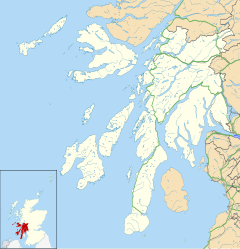
Argyll and Bute is one of 32 unitary council areas in Scotland and a lieutenancy area. The current lord-lieutenant for Argyll and Bute is Jane Margaret MacLeod. The administrative centre for the council area is in Lochgilphead at Kilmory Castle, a 19th-century Gothic Revival building and estate. The current council leader is Councillor Jim Lynch.

Tobermory is the capital of, and until 1973 the only burgh on, the Isle of Mull in the Scottish Inner Hebrides. It is located on the east coast of Mishnish, the most northerly part of the island, near the northern entrance of the Sound of Mull. The village was founded as a fishing port in 1788; its layout was based on the designs of Dumfriesshire engineer Thomas Telford. As of 2022 its population was 1,045. It is notable as the location for the 2002–05 children's programme Balamory by the BBC.

The Isle of Mull or simply Mull is the second-largest island of the Inner Hebrides and lies off the west coast of Scotland in the council area of Argyll and Bute.
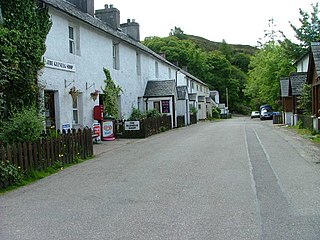
Glenelg is a scattered community area and civil parish in the Lochalsh area of Highland in western Scotland.
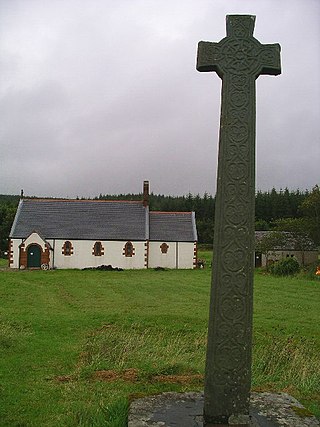
Morvern, historically also spelt Morven, is a peninsula and traditional district in the Highlands, on the west coast of Scotland. It lies south of the districts of Ardgour and Sunart, and is bounded on the north by Loch Sunart and Glen Tarbert, on the south east by Loch Linnhe and on the south west by the Sound of Mull. The highest point is the summit of the Corbett Creach Bheinn which reaches 853 metres (2,799 ft) in elevation.

Bonnavoulin or Bunavullin is a village on the Morvern peninsula in the Highlands of Scotland. Situated at the northern terminus of the B849, it is about 10 miles from Lochaline and on the eastern shore of the Sound of Mull opposite the isle of Mull and is in the Highland Council area.

MV Loch Fyne is a Caledonian MacBrayne car ferry, owned by Caledonian Maritime Assets Limited, built in 1991 for the Isle of Skye crossing and now operating the Mallaig to Armadale route in western Scotland. She becomes a relief vessel in the winter, covering other vessels for annual overhaul and any breakdowns.
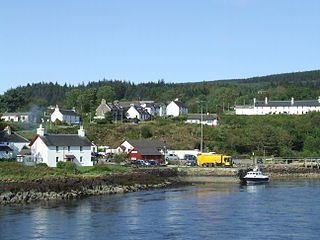
Lochaline is the main village in the Morvern area of Highland, Scotland. The coastal village is situated at the mouth of Loch Aline, on the northern shore of the Sound of Mull. A ferry operates regularly over to Fishnish on the Isle of Mull.

MV Canna is a car ferry built for Caledonian MacBrayne (CalMac) in 1975. She spent 21 years in various locations on the west of Scotland and 20 years at Rathlin Island, Northern Island, before moving to Arranmore.

The Corran Ferry crosses Loch Linnhe at the Corran Narrows, south of Fort William, Scotland.

MV Loch Dunvegan is a Caledonian Maritime Assets Limited car ferry built for the Isle of Skye crossing and now operating in the Kyles of Bute, Argyll and Bute, Scotland. She is operated by Caledonian MacBrayne (CalMac).

MV Loch Alainn is a Caledonian Maritime Assets Limited ferry built in 1997 and operated by Caledonian MacBrayne. Berthing problems on her intended route at Fishnish meant she began a decade of service at Largs. Since 2007, she has operated across the Sound of Barra.

MV Loch Linnhe is a Caledonian Maritime Assets Limited ro-ro car ferry, built in 1986 and operated by Caledonian MacBrayne After over ten years at Largs, she was the summer vessel on the Tobermory–Kilchoan crossing from 1999 to 2017.

MV Isle of Cumbrae is a Caledonian Maritime Assets Limited ro-ro car ferry, built in 1976 and operated by Caledonian MacBrayne. For ten years she was at Largs and operated the Loch Fyne crossing from 1999 to 2014. She was replaced by the MV Lochinvar in 2014, a new diesel-electric hybrid ferry capable of holding 23 cars and 150 passengers. She returned to Tarbert in 2016 after MV Lochinvar was moved to the Mallaig - Armadale station. As of 2024, she is the oldest vessel in the CalMac fleet.
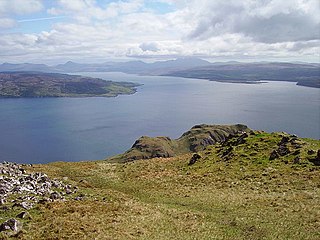
The Sound of Mull is a sound between the Inner Hebridean island of Mull and mainland Scotland. It forms part of the Atlantic Ocean.

The Sound of Islay is a narrow strait between the islands of Islay and Jura off the west coast of Scotland. It is about 30 kilometres in extent from north to south and lies between Rubh' a' Mhàil on Islay and Rubh' Aird na Sgitheich on Jura to the north and Macarthur's Head and Rubha na Tràille to the south. The islands in the Sound are Am Fraoch Eilean, Brosdale Island and Glas Eilean, all of which are off the south east coast of Jura. These islands, Jura south of Loch Tarbert and the eastern part of the Sound are one of 40 National Scenic Areas in Scotland.

Caledonian Maritime Assets Limited owns the ferries, ports, harbours and infrastructure for the ferry services serving the west coast of Scotland, the Firth of Clyde and the Northern Isles.

MV Hallaig is a pioneering Diesel Electric Hybrid ferry built for the Caledonian MacBrayne service between Skye and Raasay.

MV Lochinvar is a pioneering diesel electric hybrid ferry built for Caledonian MacBrayne. Initially, she operated between Tarbert and Portavadie, was moved to the Mallaig to Armadale route in 2016 and currently operates on the Lochaline to Fishnish route. She is one of only three passenger and vehicle roll-on, roll-off ferries in the world to incorporate a low-carbon hybrid system of diesel electric and lithium-ion battery power and is the second hybrid ferry commissioned and owned by Caledonian Maritime Assets. The ferries are sea-going and are 43.5 m (143 ft) long, accommodating 150 passengers, 23 cars or two HGVs. The first ferry, MV Hallaig, entered service on the Sconser to Raasay route in October 2013. The third sister ship, MV Catriona, entered service in 2016.
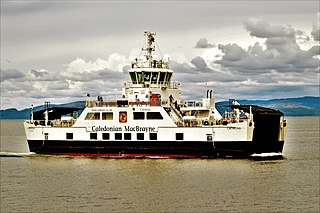
MV Catriona is a diesel electric hybrid passenger and vehicle roll-on, roll-off ferry built for Caledonian MacBrayne for the Claonaig–Lochranza crossing. She is the third hybrid ferry commissioned and owned by Caledonian Maritime Assets, one of three such ferries in the world to incorporate a low-carbon hybrid system of diesel electric and lithium-ion battery power. The ferries are sea-going and are nearly 46 metres (150 ft) long, accommodating 150 passengers, 23 cars or two HGVs.

